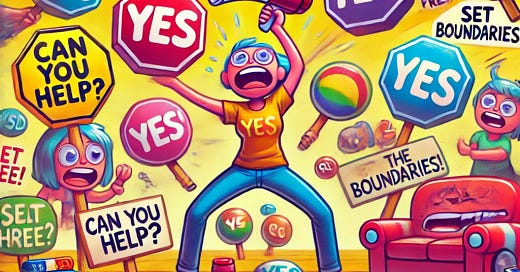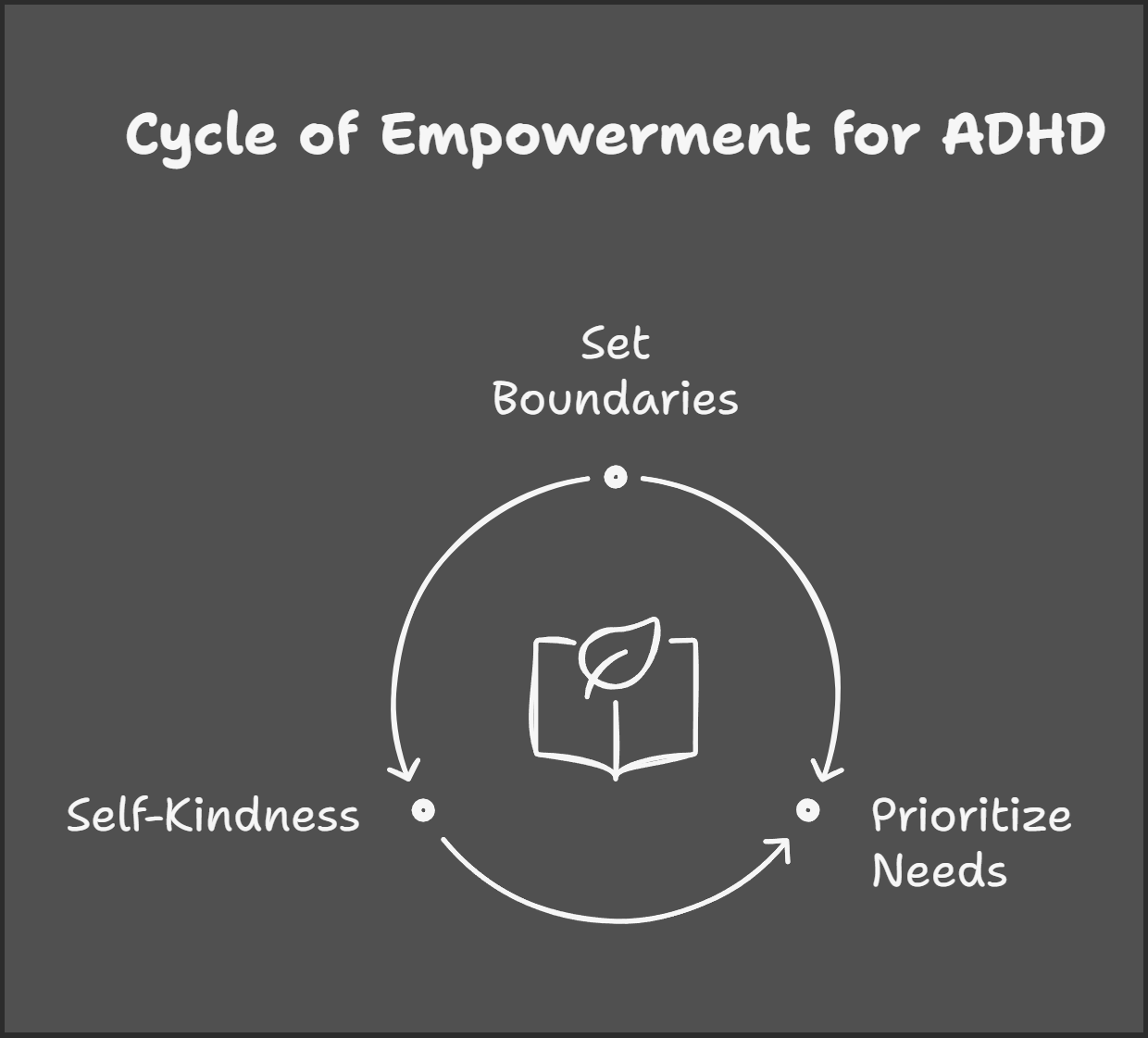How to Break Free from the ADHD People-Pleasing Trap 🤗: Set Boundaries 🚧 and Reclaim Your Energy ⚡!
Learn how ADHD fuels the urge to please others 🤝, why it leaves you drained 🧠💔, and discover practical steps to set boundaries 🚧, prioritize yourself 🧘♂️ and thrive 🌱
Anna was known as the "dependable one." Growing up, she learned to avoid conflict by always saying “yes” 🤝—whether it was smoothing over arguments or going above and beyond for friends. As an adult, she feared letting people down 🙇♀️ and often sacrificed her own needs to keep others happy.
But deep down, she felt drained 🥱, unheard 🤐 and frustrated 😤.
If you have ADHD, you might relate to Anna’s struggles.
Why? Because ADHD brains are wired to avoid rejection 🚫 seek harmony 🤝 and overcommit 🌀— all while ignoring their own limits.
Let’s break this cycle together! 💪
The Burden of Constant People-Pleasing 💔
The constant need to please others can feel like carrying a heavy weight on your shoulders. Every "yes" adds a little more to the load. At first, it feels good to be liked or needed 😌, but over time, it leaves you feeling drained, overwhelmed and stuck in a loop of trying to satisfy everyone but yourself. 😞
The more you please, the more others expect. This can become an exhausting cycle 🌀especially when your ADHD makes it hard to assert yourself and set limits. 🌟
Why ADHD Makes Us “Too Nice”? 🤔🧠🤷♂️
ADHD is often linked to a pattern of behavior where individuals find themselves overcommitting 📝, overexerting 💪, and constantly saying "yes" ✅ to avoid conflict ⚔️. This drive to please others 🤗 and avoid rejection 😔 becomes a default setting for many ADHD’ers. 🌪️
Here are some possible causes of why we ADHD’ers 'people please':
1️⃣ Childhood Survival Skills 🧸
Growing up in chaotic or high-pressure environments often teaches ADHD’ers to play the peacemaker 🕊️. This pattern can stick with us as adults, making us feel like we always have to keep the peace. 🛑
2️⃣ Rejection Sensitive Dysphoria (RSD) 😔
Fear of disappointing others or feeling judged can make even minor conflicts feel unbearable 😥, so we avoid them at all costs. This can lead to a pattern of saying "yes" even when we don't want to. 🚫
3️⃣ Impulsivity + Emotional Sensitivity 🤯
Saying “yes” on impulse feels like the quickest way to avoid stress and confrontation 😩. We might regret it later, but in the moment, it feels easier than saying “no.” ⏳
4️⃣ The Need to Be Liked 🤝
For many ADHD’ers, our sense of worth gets tangled up in being liked or praised 🙌. The thought of upsetting someone can feel like personal failure 💔. It’s hard to let go of that need for approval. 😟
5️⃣ Low Frustration Tolerance 😬
We may avoid conflict or confrontation because it feels uncomfortable. So, we go along with what others want, even when it's not in our best interest. 😔
6️⃣ Difficulty Prioritizing 🥺
ADHD makes it hard to prioritize ourselves over others, leading to burnout and resentment. 🔥
7️⃣ Sacrificing Yourself 😓
Prioritizing others over your own needs leads to burnout and emotional exhaustion.
8️⃣ The Guilt Cycle 💥
ADHD creates heightened sensitivity 💥, making guilt 😞 and fear of rejection 😔 powerful motivators.
9️⃣ Unrealistic Standards 🌍
Trying to please everyone is unsustainable and can erode self-esteem 💔.
Understanding these patterns 🧠 is the first step toward healthier boundaries 🚧 and relationships 🤝.
How This Impacts You 💡🔍
1️⃣ Burnout 🔥🛑
Constantly prioritizing others over yourself drains your energy, leaving you emotionally exhausted.
2️⃣ Lack of Boundaries 🚪❌
Saying “yes” too often leaves no room for your goals or self-care.
3️⃣ Resentment esentment 🧨😠
Over time, the pressure builds. You might start feeling resentful toward others —or even yourself.
4️⃣ Unbalanced Relationships ⚖️👫
When you're “too nice,” people might unintentionally (or intentionally) take advantage of your kindness.
How to Break Free:
Practical Steps to Set Boundaries and Reclaim Your Energy ⚡
1️⃣ Recognize the Pattern 🔍
The first step to breaking free from people-pleasing is recognizing when you're doing it. Pay attention to times when you say "yes" out of impulse rather than intention. 🚨
2️⃣ Start Small with "NO" 🚫
Saying "no" doesn’t come easy, but start small. Practice saying "NO" in low-stakes situations to build confidence 💪. It gets easier over time!
3️⃣ Set Clear Boundaries 🚧
Boundaries are essential for your mental health! You need to communicate clearly about what you can and can’t do, even if it feels uncomfortable at first. 📢
4️⃣ Give Yourself Permission to Prioritize You 🧘♂️
It's okay to put your needs first. You don’t have to sacrifice your well-being for others. You matter too! ❤️
5️⃣ Build a Support System 🤝
Surround yourself with people who respect your boundaries and help you stay accountable. A good support system will cheer you on as you learn to say "no." 🌟
Key Takeaways: 💡
ADHD can drive you to over-please: Impulsivity and conflict avoidance are common reasons why people with ADHD struggle with saying "no" 🤯.
Setting boundaries is essential: Without boundaries, you'll end up exhausted and resentful 😤.
Prioritize yourself: It's okay to say "NO" and take care of your own needs before those of others 🧘♂️
Break Free and Thrive! 🌱
Being "too nice" can feel like a trap that holds you back, especially when ADHD is in the mix 😣.
But you can take control by setting boundaries 🚧
prioritizing your own needs 💖
and being kind to yourself 🌸.
A Final Thought 🌈
The road to breaking free from people-pleasing won’t be perfect, but every step forward is a victory 🏆.
Keep practicing and soon you’ll be living a life where your energy
is yours to control. ✨.
Take care of yourself and remember, saying "NO" is an act of self-love 💖.
You’ve got this! 🌟
Drop a comment below and share your tips on setting boundaries and reclaiming your energy.
Let’s support each other! 🙌💬









